About This Item
Densité de vapeur
7.6 (vs air)
Niveau de qualité
Pression de vapeur
<0.01 mmHg ( 20 °C)
Essai
≥99.0% (GC)
Forme
powder
Température d'inflammation spontanée
878 °F
pb
265 °C (lit.)
Pf
69-73 °C (lit.)
Solubilité
ethanol: 100 mg/mL
vegetable oils: soluble
Chaîne SMILES
Cc1cc(c(O)c(c1)C(C)(C)C)C(C)(C)C
InChI
1S/C15H24O/c1-10-8-11(14(2,3)4)13(16)12(9-10)15(5,6)7/h8-9,16H,1-7H3
Clé InChI
NLZUEZXRPGMBCV-UHFFFAOYSA-N
Informations sur le gène
human ... CAPN1(823)
rat ... Capn1(29153), Nos1(24598)
Vous recherchez des produits similaires ? Visite Guide de comparaison des produits
Catégories apparentées
Application
- Thermal decomposition characteristics of BHT and its peroxide (BHTOOH): BHT is highlighted for its excellent antioxidant properties, which degrade into BHTOOH under specific conditions (S Dai, et al., 2024).
- Relaxation mechanisms in low-stress polymer networks: BHT is utilized in polymer networks to assess its effects on the mechanical properties and durability of dental composites (SH Lewis, et al., 2024).
- Compatibility and safety of labels for pharmaceutical packaging: The study found BHT in labels, indicating its widespread use in pharmaceutical packaging due to its stabilizing properties (C Fu, et al., 2023).
Actions biochimiques/physiologiques
Mention d'avertissement
Warning
Mentions de danger
Conseils de prudence
Classification des risques
Aquatic Acute 1 - Aquatic Chronic 1
Code de la classe de stockage
11 - Combustible Solids
Classe de danger pour l'eau (WGK)
WGK 2
Point d'éclair (°F)
260.6 °F - open cup
Point d'éclair (°C)
127 °C - open cup
Équipement de protection individuelle
dust mask type N95 (US), Eyeshields, Gloves
Faites votre choix parmi les versions les plus récentes :
Certificats d'analyse (COA)
Vous ne trouvez pas la bonne version ?
Si vous avez besoin d'une version particulière, vous pouvez rechercher un certificat spécifique par le numéro de lot.
Déjà en possession de ce produit ?
Retrouvez la documentation relative aux produits que vous avez récemment achetés dans la Bibliothèque de documents.
Notre équipe de scientifiques dispose d'une expérience dans tous les secteurs de la recherche, notamment en sciences de la vie, science des matériaux, synthèse chimique, chromatographie, analyse et dans de nombreux autres domaines..
Contacter notre Service technique